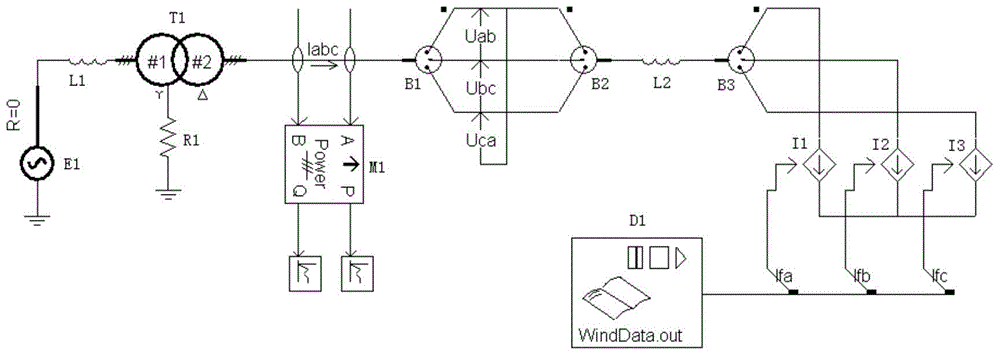Simulation modeling method for wind farm dynamic reactive power compensation capacity optimization
A simulation modeling, wind farm technology, applied in the direction of reactive power compensation, reactive power adjustment/elimination/compensation, circuit devices, etc., can solve the problem that it is difficult to fully display the reactive power and voltage variation rules of wind farms, and achieve a matching degree high effect
- Summary
- Abstract
- Description
- Claims
- Application Information
AI Technical Summary
Problems solved by technology
Method used
Image
Examples
Embodiment Construction
[0022] The technical solutions of the present invention will be further described below in conjunction with the accompanying drawings and embodiments.
[0023] Such as figure 1 The wind farm system model is shown based on the actual wave recording data in the field. In the model, E1 is the system power supply, L1 and L2 are the equivalent inductance of the simulated line, T1 is the main transformer of the wind farm, and M1 is the active and reactive power of the low-voltage side of the main transformer. Power measurement module, Iabc, Uab, Ubc, Uca are main transformer low-voltage side phase current and line voltage measurement modules respectively, B1~B3 are line splitters, I1, I2, I3 are wind farm system equivalent load reactive current sources , D1 is the reactive current data file imported into the PSCAD simulation environment after the actual measured data of the wind farm is converted, and the three-phase reactive current Ifa, Ifb, Ifc is output to control the load curre...
PUM
 Login to View More
Login to View More Abstract
Description
Claims
Application Information
 Login to View More
Login to View More - R&D
- Intellectual Property
- Life Sciences
- Materials
- Tech Scout
- Unparalleled Data Quality
- Higher Quality Content
- 60% Fewer Hallucinations
Browse by: Latest US Patents, China's latest patents, Technical Efficacy Thesaurus, Application Domain, Technology Topic, Popular Technical Reports.
© 2025 PatSnap. All rights reserved.Legal|Privacy policy|Modern Slavery Act Transparency Statement|Sitemap|About US| Contact US: help@patsnap.com

